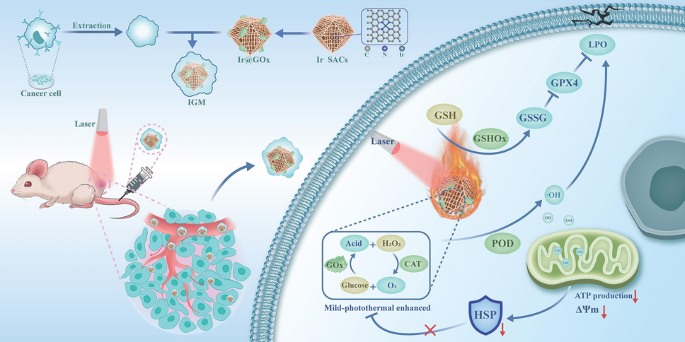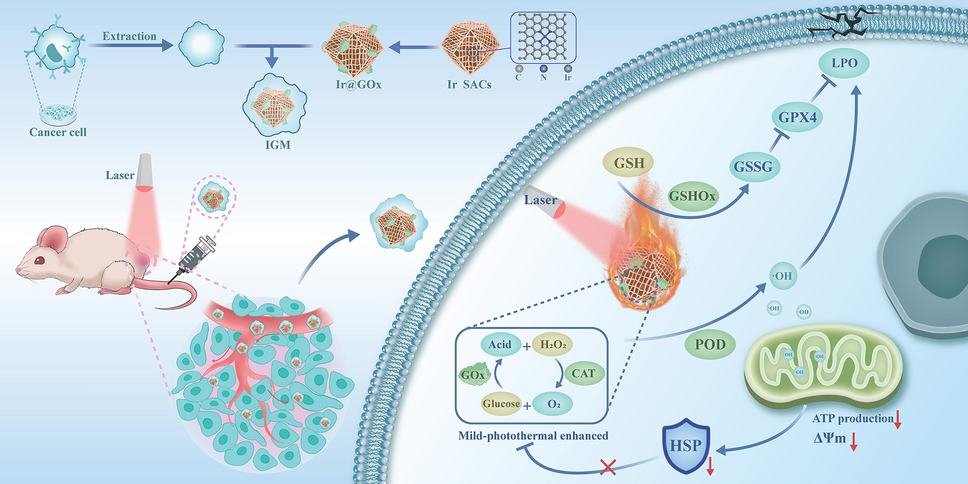Refining Single-Atom Catalytic Kinetics for Tumor Homologous-Targeted Catalytic Therapy

A groundbreaking study published in Nano-Micro Letters presents a novel approach to optimizing single-atom catalytic kinetics for tumor catalytic therapy. Led by Professor Peng Huang from Shenzhen University, the research team developed a dual-enzyme-driven cascade reaction system that significantly enhances the efficiency of catalytic therapy in tumors.
Why This Research Matters
- Improved Catalytic Efficiency: Traditional single-atom nanozymes (SAzymes) often face challenges in tumor microenvironments due to low catalytic efficiency. This study introduces a dual-enzyme cascade system integrating iridium (Ir) SAzymes with glucose oxidase (GOx), optimizing key factors such as hydrogen peroxide availability, acidity, and temperature within the tumor microenvironment.
- Homologous Targeting: The cascade reaction system was functionalized with cancer cell membranes to achieve homologous targeting and high biocompatibility. This ensures accurate accumulation at tumor sites while minimizing off-target effects.
- Multistage Enhancement: The study demonstrates a comprehensive strategy that combines dual-enzyme-driven cascade reactions with photothermal therapy, significantly improving the efficiency of catalytic therapy.
Innovative Design and Mechanisms
- Dual-Enzyme Cascade System: The researchers constructed a system where GOx catalysis produces abundant hydrogen peroxide and lowers the local pH, optimizing conditions for Ir SAzymes to generate cytotoxic hydroxyl radicals (·OH). Upon laser irradiation, the Ir SAzymes also exhibit catalase-like activity, breaking down hydrogen peroxide into oxygen and further supporting aerobic catalysis.
- Cancer Cell Membrane Camouflage: The system was modified with cancer cell membranes to improve biocompatibility and achieve tumor homologous targeting. This approach ensures that the nanoreactor accumulates efficiently at the tumor site, enhancing therapeutic efficacy.
- Photothermal Effect: The Ir SAzymes exhibit strong absorption in the near-infrared region, allowing for efficient photothermal conversion. This localized heating further enhances the catalytic activity of both enzymes, leading to more effective tumor treatment.
Applications and Future Outlook
- In Vitro and In Vivo Efficacy: The study demonstrates significant cytotoxicity and apoptosis in tumor cells treated with the dual-enzyme system, both in vitro and in vivo. The optimized catalytic kinetics led to complete tumor clearance in a mouse model, showcasing the potential for clinical applications.
- Imaging and Monitoring: The researchers used photoacoustic imaging to track the accumulation of the nanoreactor at the tumor site, confirming its effective targeting and retention. This non-invasive imaging technique provides real-time monitoring of therapeutic progress.
- Future Research: Future work could explore the application of this dual-enzyme system in other types of tumors and investigate the long-term effects of photothermal therapy in combination with catalytic therapy.
This research led by Professor Peng Huang and his team represents a significant advancement in the field of tumor catalytic therapy. Stay tuned for more exciting developments as researchers continue to explore innovative solutions for cancer treatment.
Follow the Topic
-
Nano-Micro Letters

Nano-Micro Letters is a peer-reviewed, international, interdisciplinary and open-access journal that focus on science, experiments, engineering, technologies and applications of nano- or microscale structure and system in physics, chemistry, biology, material science, and pharmacy.






Please sign in or register for FREE
If you are a registered user on Research Communities by Springer Nature, please sign in